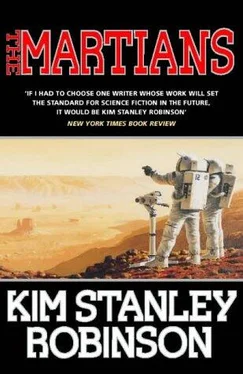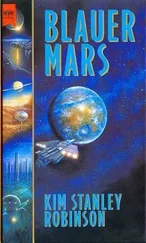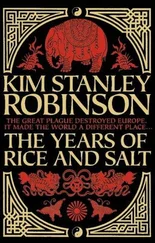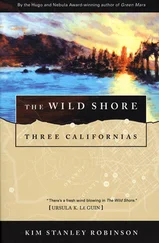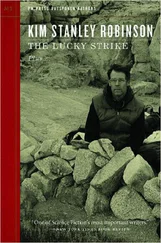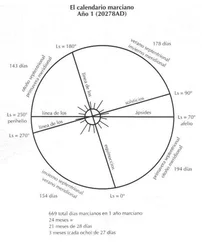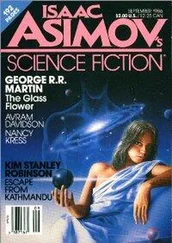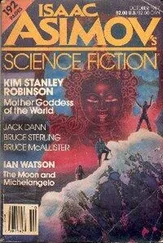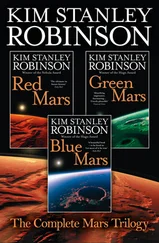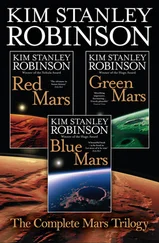It looked like what had been preserved in the samples he had been given was almost entirely what used to be called the junk DNA of the creature. In times past this would have been bad luck, but the Kohl labs in Acheron had recently been making great strides in unraveling the various purposes of junk DNA, which proved not to be useless after all, as might have been guessed, evolution being as parsimonious as it was. Their breakthrough consisted in characterizing very short and scrambled repetitive sequences within junk DNA that could be shown to code instructions for higher hierarchical operations than they were used to seeing at the gene level—cell differentiation, information order sequencing, apoptosis and the like.
Using this new understanding to unravel any clues in partially degraded fossil junk DNA would be hard, of course. But the nucleotide sequences were there in his EM images—or, to be more precise, the characteristic mineral replacements for the adenine-thymine and cytosine-guanine couplets, replacements well established in the literature, were there to be clearly identified. Nano-fossils, in effect; but legible to those who could read them. And once read, it was then possible to brew identical sequences of living nucleotides, matching the originals of the fossil creature. In theory one could re-create the creature itself, though in practice nothing like the entire genome was ever there, making it impossible. Not that there weren’t people trying anyway with simpler fossil organisms, either going for the whole thing or using hybrid DNA techniques to graft expressions they could decipher onto living templates, mostly descendants of the earlier creature.
With this particular ancient dolphin, almost certainly a freshwater dolphin (though most of these were fairly salt tolerant, living in river mouths as they did), complete resuscitation would be impossible. It wasn’t what Smith was trying to do anyway. What would be interesting would be to find fragments that did not seem to have a match in the living descendants’ genome, then hopefully synthesize living in vitro fragments, clip them into contemporary strands, and see how these experimental animals did in hybridization tests and in various environments. Look for differences in function.
He was also doing mitochondrial tests when he could, which if successful would permit tighter dating for the species’ divergence from precursor species. He might be able to give it a specific slot on the marine mammal family tree, which during the early Pliocene was very complicated.
Both avenues of investigation were labor-intensive, time-consuming, almost thoughtless work—perfect, in other words. He worked for hours and hours every day, for weeks, then months. Sometimes he managed to go home on the tram with Selena; more often he didn’t. She was writing up her latest results with her collaborators, mostly with Mark. Her hours were irregular. When he was working he didn’t have to think about that; so he worked all the time. It was not a solution, not even a very good strategy—it even seemed to be making things worse—and he had to attempt it against an ever-growing sense of despair and loss; but he did it nevertheless.
“What do you think of this Acheron work?” he asked Frank one day at work, pointing to the latest printout from the Kohl lab, lying heavily annotated on his desk.
“It’s very interesting! It makes it look like we’re finally getting past the genes to the whole instruction manual.”
“If there is such a thing.”
“Has to be, right? Though I’m not sure the Kohl lab’s values for the rate adaptive mutants will be fixed are high enough. Ohta and Kimura suggested ten percent as the upper limit, and that fits with what I’ve seen.”
Smith nodded, pleased. “They’re probably just being conservative.”
“No doubt, but you have to go with the data.”
“So—in that context—you think it makes sense for me to pursue this fossil junk DNA?”
“Well, sure. What do you mean? It’s sure to tell us interesting things.”
“It’s incredibly slow.”
“Why don’t you read off a long sequence, brew it up and venter it, and see what you get?”
Smith shrugged. Whole-genome shotgun sequencing struck him as slipshod, but it was certainly faster. Reading small bits of single-stranded DNA, called expressed sequence tags, had quickly identified most of the genes on the human genome; but it had missed some, and it ignored even the regulatory DNA sequences controlling the protein-coding portion of the genes, not to mention the so-called junk DNA itself, filling long stretches between the more clearly meaningful sequences.
Smith expressed his doubts to Frank, who nodded, but said, “It isn’t the same now that the mapping is so complete. You’ve got so many reference points you can’t get confused where your bits are on the big sequence. Just plug what you’ve got into the LanderWaterman, then do the finishing with the Kohl variations, and even if there are massive repetitions, you’ll still be okay. And with the bits you’ve got, well they’re almost like ests anyway, they’re so degraded. So you might as well give it a try.”
Smith nodded.
That night he and Selena trammed home together. “What do you think of the possibility of shotgun sequencing in vitro copies of what I’ve got?” he asked her shyly.
“Sloppy,” she said. “Double jeopardy.”
A new schedule evolved. He worked, swam, took the tram home. Usually Selena wasn’t there. Often their answering machine held messages for her from Mark, talking about their work. Or messages from her to Smith, telling him that she would be home late. As it was happening so often, he sometimes went out for dinner with Frank and other lane mates, after the evening workouts. One time at a beach restaurant they ordered several pitchers of beer, and then went out for a walk on the beach, and ended up running out into the shallows of the bay and swimming around in the warm dark water, so different from their pool, splashing each other and laughing hard. It was a good time.
But when he got home that night, there was another message on the answering machine from Selena, saying that she and Mark were working on their paper after getting a bite to eat, and that she would be home extra late.
She wasn’t kidding; at two o’clock in the morning she was still out. In the long minutes following the timeslip Smith realized that no one stayed out so late working on a paper without calling home. This was therefore a message of a different kind.
Pain and anger swept through him, first one then the other. The indirection of it struck him as cowardly. He deserved at least a revelation—a confession—a scene. As the long minutes passed he got angrier and angrier; then frightened for a moment, that she might have been hurt or something. But she hadn’t. She was out there somewhere fooling around. Suddenly he was furious.
He pulled cardboard boxes out of their closet and yanked open her drawers, and threw all her clothes in heaps into the boxes, crushing them in so they would all fit. But they gave off their characteristic scent of laundry soap and her, and smelling it he groaned and sat down on the bed, knees weak. If he carried through with this he would never again see her putting on and taking off these clothes, and just as an animal he groaned at the thought.
But men are not animals. He finished throwing her things into boxes, took them outside the front door, and dropped them there.
She came back at three. He heard her kick into the boxes and make some muffled exclamation.
He hurled open the door and stepped out.
“What’s this?” She had been startled out of whatever scenario she had planned, and now was getting angry. Her, angry! It made him furious all over again.
Читать дальше
Конец ознакомительного отрывка
Купить книгу
